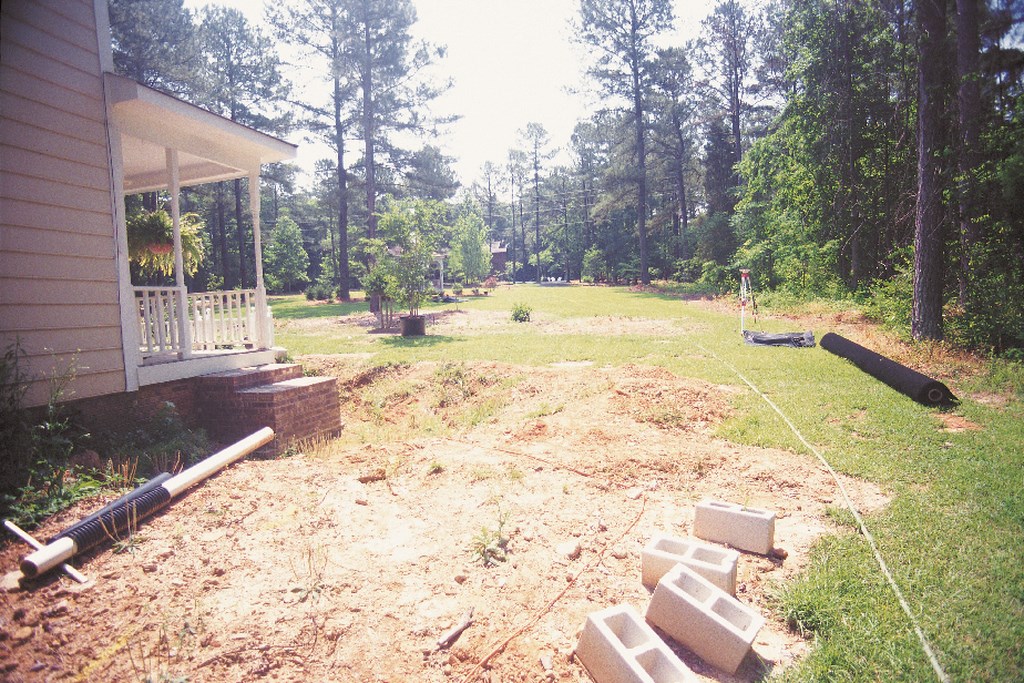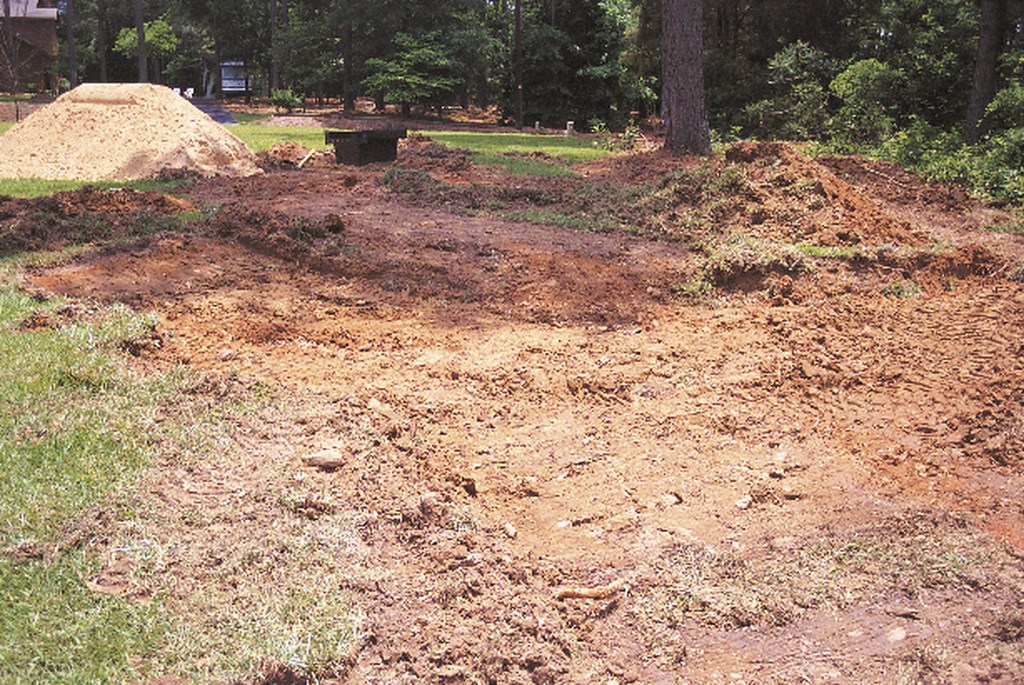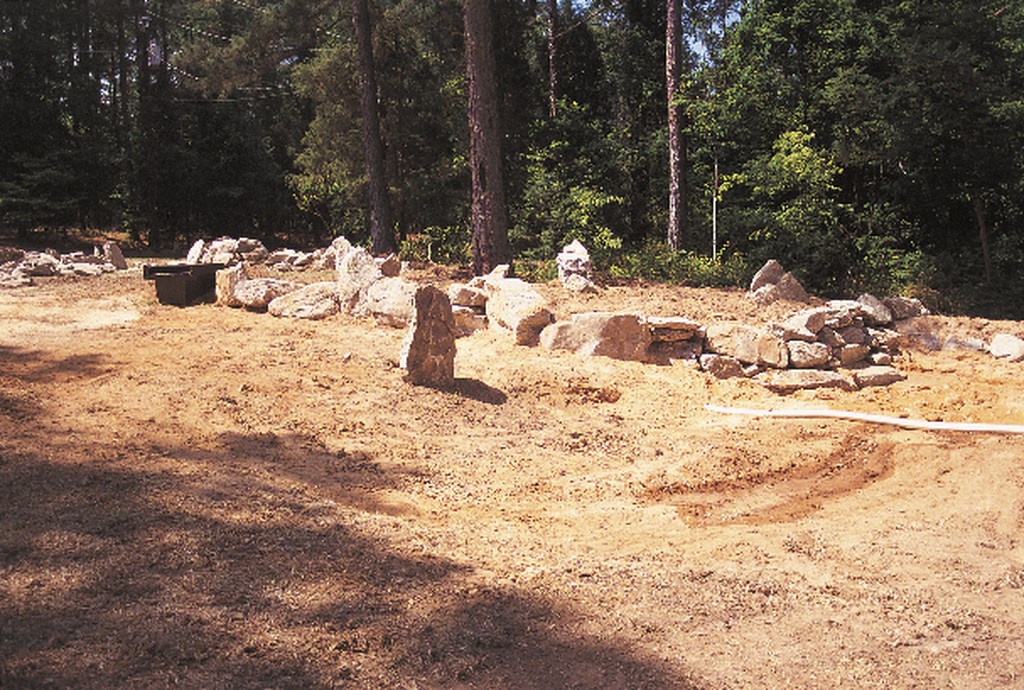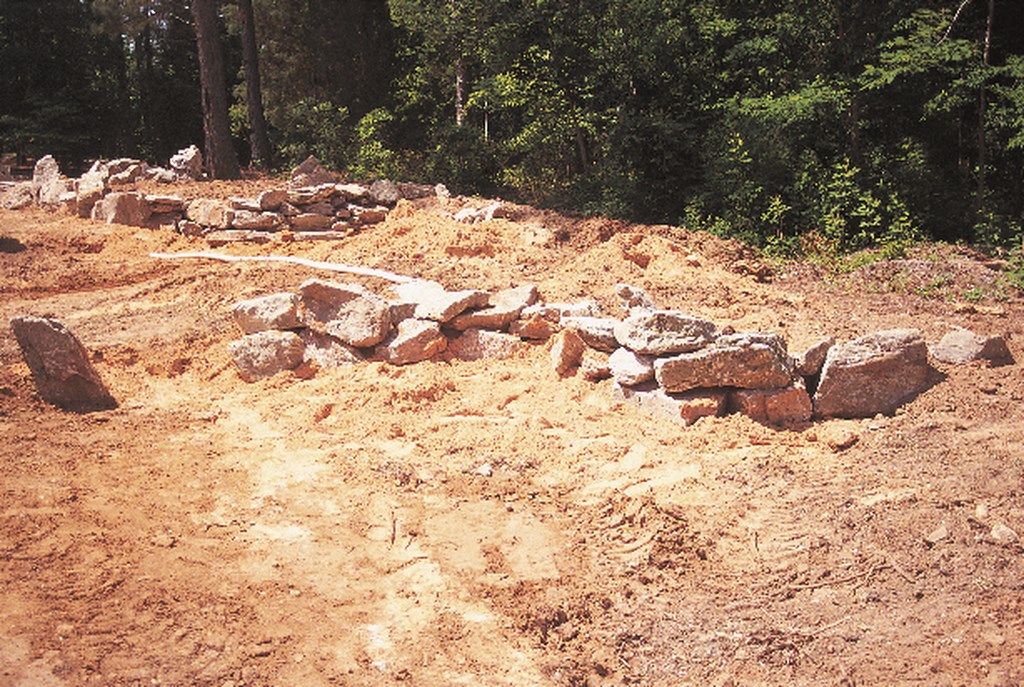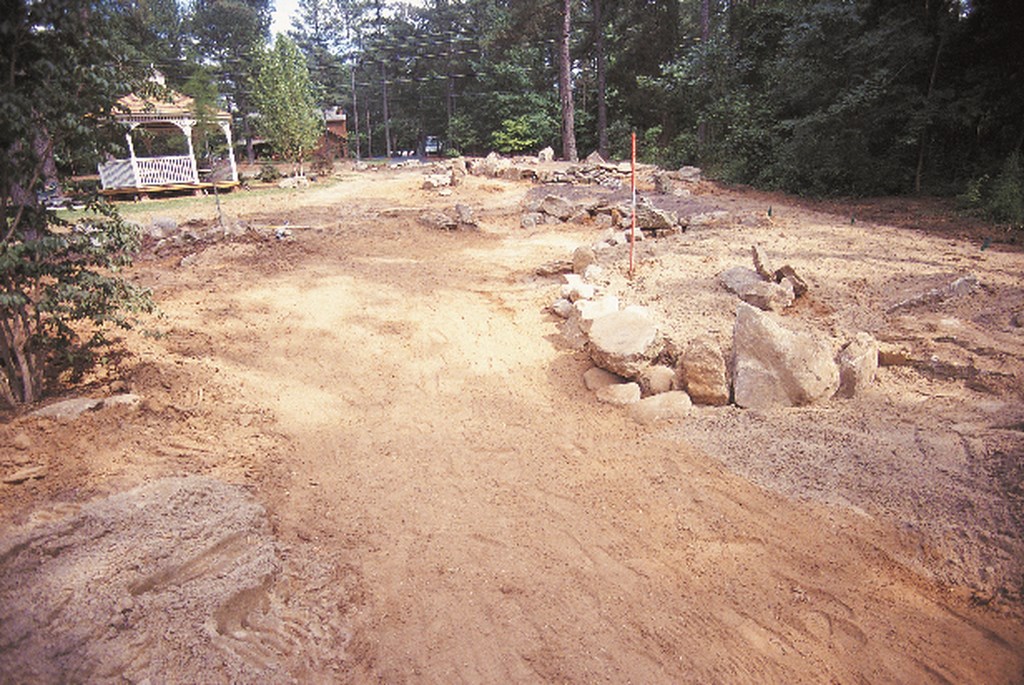Cutting a Channel

Building a stream that looks as though it was actually completed by Mother Nature is no small challenge. To make the illusion work, the watershaper quite literally “shapes” the basic elements of the stream – its path, width, depth, outcroppings, falls, transitions and plantings – all with an eye toward mimicking natural designs.
To a large degree, the process is different from that of designing and building a pond, pool or fountain. In those cases, the watershape generally goes in the ground almost exactly where and how it’s been drawn. With streams, however, the differences between drawn plans and what you actually do on site can be (and usually are) quite pronounced.
The truth about streams is that they need a little more leeway. More often than not, the key creative decisions you make will occur during construction rather than in the planning stage. The contours of the channel, the placement of rocks, the points where the flow speeds up or slows down – all these things, I’ve found, are just too difficult to define on a flat piece of paper.
For me, this backyard improvisation runs from beginning to end of the process. Let me demonstrate what I mean by taking you through the steps I follow – steps that enable me to keep my creative juices flowing as I build streams that look like the real thing.
TERMS OF SCALE
Most of what I’ll describe here applies both to large and small streams. In fact, the biggest differences you’ll run into for streams of different sizes are in the logistics of the job: The stream depicted on these pages, for example, is almost 90 feet long and flows into a 25-by-30-foot pond. That’s fairly large by residential standards and required trucking in nearly 90 tons of stone.
With 90-foot streams and 90 tons of stone, you need to think about practicalities with more focus than is the case with a 20-foot stream with, say, 15 tons of stone. Issues like delivering the stone, laying the liner and planting the landscaping are definitely more complicated with a large-scale project. That said, the basic challenge of stream building remains the same, large or small: You have to be able to make on-site adjustments as you go, based on what you know about the way nature moves water.
For most of my jobs, I like to set up an 8-foot-wide swath and let the finished stream work somewhere inside that corridor. I went through some trial and error before settling on this parameter, but I’ve found this works best because it allows me to use 10-foot-wide liners. With an 8-foot maximum width for the overall watercourse, I have enough extra material to fold up and secure the sides for the stream banks.
| Here’s the site before any work on the stream had taken place. The foreground will eventually become a pond; from this angle, we’re looking across the pond site and straight up what will eventually be the path of the stream. |
This gives me plenty of that leeway I mentioned above, because my streams rarely run to 8 feet wide and I very often work with channels no more than a foot wide in cases where elevations change dramatically. In these cases, I use the excess liner to fold around larger stones and reach up into the embankments. A wide liner also gives me opportunities to create deeper areas of streambed and more dramatic outcroppings.
Of course, this creates a lot of waste material, but I put the trimmings to good use under large boulders or to double up against any sharp outside boulders that are close to the streambed. (Quite apart from the stream, you can use the extra liner in bog gardens.)
I call so much attention to the liner because knowing the range of widths and depths you have at hand influences how you’ll lay out the shape of the stream itself.
CLEARING THE WAY
I begin the layout process with some spray paint and a few flags, just getting a sense of how the stream will work. Even here, changes from the drawings start to occur: What I’m looking for are contours in the existing topography that will work to my advantage – any twists, turns or drops that bring drama to the watershape.
These existing earthen contours constitute the “underlying structure” I’ve written about in previous articles in WaterShapes. This underlying structure drives the stream’s dynamics, and I believe it’s critical to pay close attention to these features and use them to best advantage.
| We began our work by tearing out the lawn. Within that wide patch of newly bared topsoil, we began to gouge out a streambed approximately 8 feet wide. |
In many cases, however, the job site will be a blank slate with no pronounced underlying structure – no twists, no turns, no inherent drama. This is where your study of nature comes into play. Understanding the way real streams work will help immensely in creating a complete underlying structure that brings life, dynamism and natural touches to the watershape you are about to create.
Either way – whether working with a clear underlying structure or creating it with your own grading – from the very beginning you have to know where to place the bends, the turns, twists, drops, falls and outcroppings, plus any other outside influences that will have an effect on the course of the stream.
Once all of this is clearly in mind, it’s time to start some preliminary digging.
One of the nice things about streams compared to other watershapes like pools or ponds is that you’re not really moving a tremendous amount of dirt. My tool of choice here is a skid-steer loader: It provides a fast way to get rid of the existing turf or lawn and has good digging and material-handling capability, all in the same tool.
| As we continued to gouge out the streambed (left), we began to form the transitional falls (right). Even though these contours may eventually be torn out, these early attempts let us study the space and get a feel for how the layout is working. At this stage, we also make adjustments based on what we find below the surface, working our way around large roots or native stone, for example. |
First, I’ll strip the lawn, moving it off to the side or to an area where I’ll be doing some mounding. Next, I’ll cut in from two directions on the areas where the main falls will be. This gives me a good idea of how the most important factors of the layout are going to relate to each other.
With just that much done, I get off the loader and ask myself a few key questions: Are the drops taking advantage of the existing underlying structure? Is their spacing good relative to the type of aesthetic I want to create; whether it’s tumbling, jumbled, mountain-like, rushing, or lazy? Most important, what is the relationship of what I’ve done to the primary view or views? Does the composition look good from the points at which most people will see the stream?
REACHING FOR CLARITY
If you’re dissatisfied with what you see at this point, back up and take time to rethink the positioning of the major elements. It’s important to rework whatever is necessary at this formative stage before you go on to create the contours of the stream’s channel.
If you’re positive you’re on the right track, it’s time to continue roughing out the stream by carving out the streambed, creating the deeper areas at the bottom of waterfalls, and digging back into the banks to allow for the placement of stones and boulders. Along the way, I repeatedly step back, assess the site and make necessary adjustments. Seldom is this process either simple or clear from beginning to end!
The next step is crucial in the development of your watershape: the placement of boulders. I’ve seen a lot of projects where boulders were placed as an afterthought rather than as part of the main watershape. The results are streams that look distinctly unnatural.
| The progress on site is gradual as the stream takes shape. Here, we’ve begun working on one of the lower embankments on the backside of the stream. Our study of the site from various angles guides us here, but the work takes patience. |
I take the opposite approach, setting the waterfall anchor stones first because these highlight the most dynamic feature in a stream. Once these are set, I step back again and look at how the support stones meld into the composition. In this particular job, I ended up adding a couple of embankments on the backside. This was done in conjunction with the waterfall anchors to create a more harmonious setting.
Depth, dimensions, aesthetics, realism, mood and underlying structure should all be running through your mind as you place these stones – and the larger the stones, the more important it is to focus, because you don’t want to move the big ones over and over again as you go.
Placing these big stones before you finish the grade work has another advantage: Between the cutting out for these stones and the potential for damage by equipment and tools, it just doesn’t make sense to spend time on handwork with smaller stones before you place the big boulders.
Once the waterfall boulders are placed, I position stones in between them to tie things together. I backfill as I go, being careful to look at the placement first and always making sure I like the look of the stone formations. The great depth of the embankments on this job gave the stream an even more dynamic appearance.
Outcroppings can be put in at this time as well, along with any large plant material that will not interfere with the work of actually building the stream. I say this because you need to have good access to move materials in to construct the actual stream. By this point, however, we’ve done enough work on site to have a good feel for the overall project and its aesthetics.
THE BIG PICTURE
At this point, I step back and take a really long look at the area surrounding the streambed. What I’m looking for is opportunities to place boulders and embankments and other features outside the swath I’ve cut as a way to add depth and dimension to the composition and turn the overall setting into a really great watershape.
Beyond the aesthetic advantages, there’s also a practical bonus here: By putting as much dramatic detail as possible outside the stream, you reduce the risk of damaging the liner. Although a 45-mil EPDM liner is tough stuff, you want to keep foot traffic to a minimum and all sharp stones off the stream’s liner – and no way do you want to run a loader over it!
| Now we’re working on the upper embankment. In the background at left, you can see where the headwaters will rise. |
We sometimes set outcropping stones that have lots of jagged edges. These jagged edges cannot come in contact with the liner, so we’ll add another piece of liner or underlayment between the stone and the liner. By setting these jagged stones first and then placing the liner, there’s less chance of damaging the liner. It just makes a lot of sense to work this way rather than sliding boulders up to a liner.
The key thing to remember in this phase is that you want the construction process to be driven by the placement of these all-important outcroppings and not the other way around: Let the larger boulders dictate the final layout instead of letting the layout dictate boulder placement.
Once these key outcroppings and embankments are placed, it’s time to step back again and take another good, long look at what you’ve installed to this point.
| At this point, much of the grading has been completed. You can see clearly how we’ve sloped the streambed up toward the banks, making the liner’s base as smooth as possible (left). This was a crucial “big picture” step: With work advancing on the pond, we checked all lines of sight to make certain the relationships of the stone embankments and the pond were working (right). |
Does the work look interesting? Could the embankments and outcroppings stand alone as separate features? Do the anchor stones appear solid and stable? Is everything in place to install the liner? Do we have good access to the stream area to bring in materials? And again: Does the work look interesting?
As I look at the overall composition, I also focus on the details. Consider the rock outcroppings, for example. Could they become stand-alone fixtures without a stream running across their fronts? Do their shapes and contours have an interesting look? Does all this material visually flow down into the channel you’ve excavated for the streambed?
SETTING THE STAGE
Let me emphasize again what we’ve been trying to accomplish to this point in the project: In large streams like this one, you need to use boulders, outcroppings and terrain changes to bring life to the watershape. I believe that the best way to accomplish this is to install as many of these elements as possible before laying down the liner – and I’d hold the same to be true for smaller-scale projects, too, but with scaled-down materials.
| By now, we were satisfied that the system of embankments was working from all key viewing angles. We were then ready to move on to the next project phase, as we’ll see next time. |
I’m not advocating that all work outside the streambed be done first, mainly because we still need access points to bring in material to complete the stream itself and do not want to compromise the integrity of the liner. (Stream leaks are difficult to find, so you don’t want to push your luck!)
Of even greater importance, what you’re doing to this point is working with or defining the underlying structure and the impact it will have on the stream and the construction process. If you were to build the stream first and then try and create the outside structures, you’d be putting the cart before the horse – something I wouldn’t advise trying no matter the task.
When all this preliminary work is complete, it’s time to move on to the next phase of our stream project, including the placement of the headwaters, consideration of the way the stream transitions into a pond, lake or hidden container and, finally, a look at setting up the plumbing runs to make the system work.
Rick Anderson is owner of Ston Wurks, a landscape-design firm in Columbia, S.C. A designer and artist with 22 years of professional experience, Anderson’s work focuses on the use of natural materials, particularly stone, in naturalistic settings. He is the founder of The Whispering Crane Institute, a landscape design “think tank” dedicated to exploring our physical, emotional and spiritual relationships with the land. The institute stages Philosophy of Design Symposia each year. Anderson is a past director of the Association of Professional Landscape Designers and has contributed numerous articles to a variety of trade and consumer magazines.










